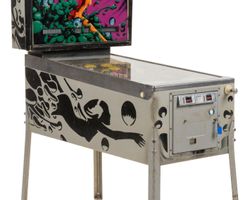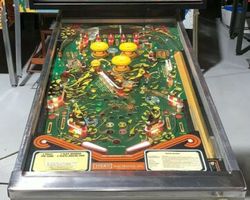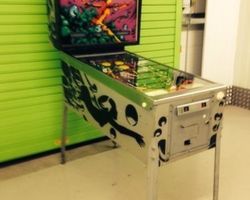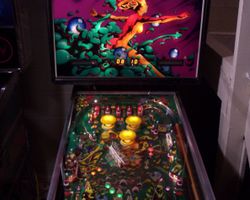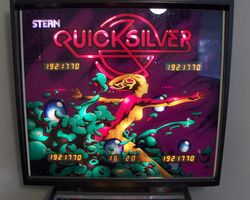Quicksilver
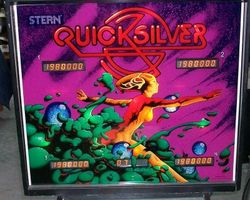
Average Prices: USD $100 to $5,800
Produced: June, 1980
Production Run: 1,201 units
Machine Type: Solid State Electronic
MPU: Stern M-200 MPU
Players: 4
Design by: Joe Joos Jr.
Art by: Doug Watson
Mechanics by: Joe Joos Jr.
Software by: Bill Pfutzenreuter
The pinball machine Quicksilver, released by Stern Electronics, Inc. in June 1980, carved out a distinct identity in the burgeoning solid-state era. Conceived and brought to life during a period of rapid innovation in pinball technology, Quicksilver emerged as a testament to the design philosophies taking root at Stern. With a production run of 1,201 units, it quickly garnered attention for its unique aesthetic and kinetic gameplay.
The creative force behind Quicksilver was multifaceted. Joe Joos Jr. took on the dual role of both game designer and mechanical engineer, a combination that often leads to highly integrated and cohesive gameplay experiences. The visual identity of Quicksilver, with its striking science fiction and fantasy themes, was crafted by artist Doug Watson. Watson’s backglass artwork, in particular, drew comparisons to the compelling imagery found in the July 1978 issue of Heavy Metal magazine, attributed to Philippe Cazaumayou, suggesting a clear stylistic inspiration that set Quicksilver apart visually. The intricate software that powered the Stern M-200 MPU, the machine’s brain, was developed by Bill Pfutzenreuter, ensuring the rules and scoring systems functioned with precision. This collaborative effort resulted in a machine that Stern Electronics boldly marketed with slogans like, "It Ain't Just Any Plain Old Silver Ball. It's the Fastest Moving Pinball Ever!", signaling its intention to deliver a high-velocity play experience. Interestingly, some Quicksilver cabinets featured a distinct "brick bottom" panel design, a visual flourish also seen on other machines from 1980, including Williams' Firepower and Stern's own Seawitch, adding a subtle layer of collectibility to these variations.
Signature Features and Design
Quicksilver’s identity is intrinsically linked to its core mechanical features and compelling visual design. The artwork, particularly the backglass, stands as a defining element. Doug Watson’s vibrant palette and thematic choices immerse players in a speculative world, a blend of futuristic elements and ethereal fantasy. This distinctive visual style is not merely decorative; it sets a tone for the game, hinting at the energy and uniqueness of the playfield within.
Mechanically, Quicksilver is built for speed and target-oriented action. It features two flippers positioned traditionally at the bottom of the playfield, complemented by three pop bumpers and two slingshots that inject kinetic chaos into ball movement. The primary scoring opportunities revolve around a significant array of targets: a four-bank of drop targets, a three-bank of drop targets, and seven standup targets strategically placed across the playfield. Two spinning targets contribute another layer of dynamic scoring, allowing for rapid point accumulation as the ball strikes and spins them. A kick-out hole provides a satisfying conclusion to certain shot sequences, often returning the ball to a flipper for continued play. These elements combine to create a machine where the physical interaction with the ball is paramount, emphasizing precision and rapid reflexes over complex ramp shots or multi-ball modes, which were less common in this era of solid-state design.
Playfield and Mechanics
The playfield of Quicksilver is designed with a direct, fast-paced approach, encouraging aggressive play and rapid ball movement. Its layout prioritizes clear shot lines to banks of targets and offers a fluid, rhythmic gameplay experience. At the center of the lower playfield resides the two flippers, providing ample control for aiming. Above them, the pop bumpers are strategically positioned to create a lively upper playfield, where the ball can careen unpredictably, racking up points and setting up subsequent shots.
The major objectives on the playfield are the distinct banks of drop targets. A four-bank and a three-bank are positioned such that sweeping them down with a single, well-aimed shot is a highly rewarding experience, both audibly and visually. These drop targets not only provide significant points but also activate other game features. The two spinning targets are integrated into key lanes, offering high-scoring opportunities for players who can repeatedly strike them. Seven standup targets are spread out, demanding precision aiming to complete various objectives. The kick-out hole, often activated by specific target completions, adds a strategic element by collecting the ball and returning it to play.
The design philosophy behind this layout is rooted in classic pinball principles: create satisfying shot geometry that is easy to understand but challenging to master. The flow is direct, with the ball often returning to the flippers quickly, facilitating rapid-fire action. The artwork on the playfield reinforces the sci-fi/fantasy theme with its use of greens, blues, and purples, creating a cohesive visual experience with the backglass. While some might find the dominant green hue unusual, it contributes to Quicksilver's distinct aesthetic. The lighting, typical of early solid-state machines, effectively highlights scoring opportunities and active targets, guiding the player's attention through the high-speed chaos.
Gameplay Dynamics
Quicksilver’s gameplay dynamics are characterized by speed, immediate feedback, and a unique approach to bonus accumulation. The primary objective revolves around spelling out "Quicksilver" by hitting specific targets and completing various shot sequences, though the general emphasis is on continuous action and scoring. Points are accumulated by hitting drop targets, with significant rewards for clearing entire banks. The two spinning targets are excellent sources of points, offering rapid accumulation for sustained hits. Pop bumpers and slingshots provide auxiliary scoring while keeping the ball in motion.
The machine truly distinguishes itself with its bonus system. Unlike many games of the era, Quicksilver's bonus is not a static value. It increases with each level achieved during play, making the bonus at the end of a ball a highly anticipated event. This "unusual bonus system" creates a powerful incentive to keep the ball in play and advance through bonus levels, adding a layer of strategic depth to the otherwise straightforward gameplay. Another distinct feature is the "rotating extra ball light," which adds an element of anticipation as players work towards earning additional opportunities. The bonus countdown, triggered at the end of a ball, provides a suspenseful moment as accumulated points are tallied.
Quicksilver rewards aggressive play and a keen eye for target completion. Sweeping the drop targets is a satisfying strategic element that not only scores points but also contributes to overall progression. The game's fast and responsive nature, often highlighted by players, means that quick reflexes and precise flipper control are paramount for achieving high scores. The excellent sound design of the era, particularly the distinct sounds of the pop bumpers and the kick-out hole, provides immediate auditory feedback that enhances the sense of speed and accomplishment. The maximum displayed point score of 9,999,990 points per player provides a challenging target for competitive play.
Reception and Legacy
Quicksilver has largely garnered a strong, positive reception within the pinball community. It is frequently described as a "classic" and a "gem" among early solid-state machines, highly sought after by collectors for its addictive and engaging play. Players consistently praise its fast-paced nature, which encourages replayability and the pursuit of higher scores. The playfield layout, with its emphasis on drop targets and spinners, is often cited as a strength, offering variety in shot opportunities and a rewarding sensation when targets are successfully cleared. The game's sound design is widely lauded for capturing the essence of the era, with the distinct sounds of its pop bumpers and kick-out hole contributing significantly to the player experience. Furthermore, the artwork, especially the backglass, is frequently commended for its stunning and unique aesthetic, with its vibrant colors leaving a lasting impression. The unusual bonus system is also a point of appreciation, adding a strategic twist to the traditional scoring mechanics.
While the overwhelming sentiment is positive, some minor critiques exist. A few players have found the gameplay to become repetitive after extended sessions, a common observation for machines of this vintage with simpler rule sets. The artwork, while broadly appreciated, has occasionally been described as "strange" or featuring "too much green" by a subjective minority, highlighting how visual taste can vary. Another challenge noted by collectors is the difficulty in finding well-preserved playfields due to the machine's age and heavy play. Additionally, the placement of certain drop targets has been described as occasionally awkward for some shot angles.
Despite these minor points, Quicksilver’s legacy is robust. It is remembered as a highly desirable and relatively rare machine, owing to its limited production run of 1,201 units. Its focus on fast, direct gameplay, combined with a unique bonus system and a distinctive visual style, set it apart. Quicksilver stands as an example of Stern Electronics' early solid-state design capabilities, showcasing how a straightforward yet challenging layout, coupled with compelling artwork, could create an enduring and captivating pinball experience that continues to resonate with enthusiasts today.
Sponsored Links
 Ebay Listings
Ebay Listings
 Auction Results
Auction Results
| Cost | Location | Date |
|---|---|---|
| USD $6,300 |  Florida, United States Florida, United States |
24 November, 2024 |
| USD $3,500 |  Texas, United States Texas, United States |
23 March, 2024 |
| USD $8,250 |  Ohio, United States Ohio, United States |
08 March, 2024 |
| USD $5,800 |  New York, United States New York, United States |
07 September, 2023 |
| USD $5,750 |  Ohio, United States Ohio, United States |
07 February, 2022 |
| USD $7,500 |  Florida, United States Florida, United States |
06 August, 2021 |
| USD $10,499 |  California, United States California, United States |
26 August, 2020 |
| USD $10,499 |  California, United States California, United States |
09 February, 2020 |
| USD $8,500 |  New York, United States New York, United States |
14 December, 2019 |
| USD $6,500 |  Florida, United States Florida, United States |
06 September, 2019 |


Private Policy · Search Website · Contact Us
As an eBay Partner, we may earn a commission from qualifying purchases made through links on this site, at no additional cost to you.
All trademarks and copyrighted materials remain property of their respective owners. All other content copyright 2007 - 2025 Pinpedia.

